Optimization of Impervious Surface Space Layout for Prevention of Urban Rainstorm Waterlogging: A Case Study of Guangzhou, China
Abstract
1. Introduction
- (1)
- Can the optimization of impervious surface space layout reduce surface runoff? How can it be achieved?
- (2)
- Does ACO-SCS based on geographic simulation technology realize the optimization of impervious surface space layout? What is the effect of optimization?
- (3)
- How does the optimization result serve urban renewal planning for urban rainstorm waterlogging prevention?
2. Materials and Methods
2.1. Study Area
2.2. Data and Preprocessing
2.3. Optimization Model of Impervious Surface Space Layout
2.3.1. SCS-CN
2.3.2. Ant Colony Optimization
Probability Function
Heuristic Function
The Generation of Ant Colony
Suitability Evaluation of Ants
Update Operation of Pheromone Concentration
Parameter Settings
Integration of Ant Colony Optimization and Soil Conservation Service Curve Number Model
- (1)
- Set the initial parameters of the algorithm, including the heuristic factor, the expecting factor, the initial pheromone, the volatilization factor, the number of iterations, and the constant coefficient.
- (2)
- Configuration process of impervious surfaces: The heuristic function and the probability function are calculated according to the pheromone. The runoff plot is used as an optimization unit. Each grid cell of each ant was configured with an impervious surface type in turn. Prohibited regions and the number of impervious surface types constrain the optimization regions and areas.
- (3)
- Suitability evaluation of the ants: Impervious surfaces with completed spatial configuration are input as a parameter into SCS-CN to calculate the surface runoff (i.e., the suitability of the ant). The top ten ants with the best suitability were selected. Compared with the optimum impervious surface space layout of the previous iteration, the optimum impervious surface space is selected.
- (4)
- Update operation of pheromone concentration: The increment and volatility of pheromones were calculated according to the top ten ants with the current optimum suitability, and then the pheromone concentration was updated.
- (5)
- Condition for stopping the algorithm: If the current iteration number reaches the maximum iteration number, the algorithm ends. The current optimal space layout of impervious surfaces is the final result. Instead, repeat step 2 until the maximum number of iterations is reached. When iteration stops, runoff coefficients before and after optimization are calculated by the SCS-CN model, and the optimization rate is obtained by comparison.
- (6)
- Adjustment of the area of impervious surface: First, the increment of the runoff coefficient of each grid element after iteration is calculated and sorted. Second, the impervious surface type corresponding to the grid cell with the largest increment of runoff coefficient remains unchanged. The adjusted impervious surface area is calculated and compared to the initial impervious area. If the result is not lower than the limited area, the adjusted impervious surfaces repeat the above operation until the area is closest to the standard.
2.4. Landscape Pattern Index
3. Results
3.1. Comparison of Impervious Surface Changes after Optimization
3.2. Landscape Pattern Change
4. Discussion
4.1. Evaluation of Optimization Model
4.2. The Influence of Various Factors on the Optimization of Impervious Surface Space Layout
4.2.1. The Influence of Input Factors on the Optimization of Impervious Surface Space Layout
4.2.2. The Influence of Initial Impervious Surface Space Layout on the Optimization Model
Relationship between Optimization Rate and Proportion of Impervious Surface Type
Relationship Between Optimization Rate and Space Layout of the Initial Impervious Surfaces
4.3. Practical Significance of Optimal results
5. Conclusions
Author Contributions
Funding
Acknowledgments
Conflicts of Interest
References
- Campbell, A.; Pradhanang, S.M.; Kouhi Anbaran, S.; Sargent, J.; Palmer, Z.; Audette, M. Assessing the impact of urbanization on flood risk and severity for the pawtuxet watershed, Rhode Island. Lake Reserv. Manag. 2018, 34, 74–87. [Google Scholar] [CrossRef]
- Löwe, R.; Urich, C.; Domingo, N.S.; Mark, O.; Deletic, A.; Arnbjerg-Nielsen, K. Assessment of urban pluvial flood risk and efficiency of adaptation options through simulations—A new generation of urban planning tools. J. Hydrol. 2017, 550, 355–367. [Google Scholar] [CrossRef]
- Akter, A.; Mohit, S.A.; Chowdhury, M.A.H. Predicting urban storm water-logging for Chittagong city in bangladesh. Int. J. Sustain. Built Environ. 2017, 6, 238–249. [Google Scholar] [CrossRef]
- Rojas, O.; Mardones, M.; Rojas, C.; Martínez, C.; Flores, L. Urban growth and flood disasters in the coastal river basin of south-central Chile (1943–2011). Sustainability 2017, 9, 195. [Google Scholar] [CrossRef]
- Subrina, S.; Chowdhury, F.K. Urban dynamics: An undervalued issue for water logging disaster risk management in case of Dhaka city, Bangladesh. Procedia Eng. 2018, 212, 801–808. [Google Scholar] [CrossRef]
- Hu, S.L.; Han, C.F.; Meng, L.P. A scenario planning approach for propositioning rescue centers for urban waterlog disasters. Comput. Ind. Eng. 2015, 87, 425–435. [Google Scholar] [CrossRef]
- Yin, J.; Ye, M.; Yin, Z.; Xu, S. A review of advances in urban flood risk analysis over China. Stoch. Environ. Res. Risk Assess. 2015, 29, 1063–1070. [Google Scholar] [CrossRef]
- Quan, R.; Zhang, L.; Min, L.; Min, L.; Wang, J.; Niu, H. Risk assessment of rainstorm waterlogging on subway in central urban area of Shanghai, China based on scenario simulation. Nat. Hazards 2014, 73, 1569–1585. [Google Scholar] [CrossRef]
- Zhang, X.; Hu, M.; Chen, G.; Xu, Y. Urban rainwater utilization and its role in mitigating urban waterlogging problems—A case study in Nanjing, China. Water Resour. Manag. 2012, 26, 3757–3766. [Google Scholar] [CrossRef]
- Hu, B.-B.; Zhou, J.; Wang, J.; Xu, S.-Y.; Meng, W.-Q. Risk assessment on rainstorm waterlogging of tianjin binhai new area based on scenario simulation. Sci. Geogr. Sin. 2012, 32, 846–852. [Google Scholar]
- Chen, Z.; Yin, L.; Chen, X.; Wei, S.; Zhu, Z. Research on the characteristics of urban rainstorm pattern in the humid area of southern china: A case study of Guangzhou city. Int. J. Climatol. 2016, 35, 4370–4386. [Google Scholar] [CrossRef]
- Chen, P.; Zhang, J.; Zhang, L.; Sun, Y. Evaluation of resident evacuations in urban rainstorm waterlogging disasters based on scenario simulation: Daoli district (Harbin, China) as an example. Int. J. Environ. Res. Public Health 2014, 11, 9964–9980. [Google Scholar] [CrossRef] [PubMed]
- Chen, P.; Zhang, J.; Jiang, X.; Liu, X.; Bao, Y.; Sun, Y. Scenario simulation-based assessment of trip difficulty for urban residents under rainstorm waterlogging. Int. J. Environ. Res. Public Health 2012, 9, 2057–2074. [Google Scholar] [CrossRef] [PubMed]
- Wang, X.; Xie, H. A review on applications of remote sensing and geographic information systems (GIS) in water resources and flood risk management. Water 2018, 10, 608. [Google Scholar] [CrossRef]
- Tang, X.; Shu, Y.; Lian, Y.; Zhao, Y.; Fu, Y. A spatial assessment of urban waterlogging risk based on a Weighted Naïve Bayes classifier. Sci. Total Environ. 2018, 630, 264. [Google Scholar] [CrossRef] [PubMed]
- Brunetti, G.; Šimůnek, J.; Piro, P. A comprehensive numerical analysis of the hydraulic behavior of a permeable pavement. J. Hydrol. 2016, 540, 1146–1161. [Google Scholar] [CrossRef]
- Hafsi, R.; Ouerdachi, L.; Kriker, A.E.; Boutaghane, H. Assessment of urbanization/impervious effects on water quality in the urban river annaba (eastern Algeria) using physicochemical parameters. Water Sci. Technol. 2016, 74, 2051–2059. [Google Scholar] [CrossRef]
- Muhammad, S.; Reeho, K. Retrofitting the low impact development practices into developed urban areas including barriers and potential solution. Open Geosci. 2017, 9, 240–254. [Google Scholar]
- Lee, E.S.; Lee, D.K.; Kim, S.H.; Lee, K.C. Design strategies to reduce surface water flooding in a historical district. J. Flood Risk Manag. 2018, 11, S838–S854. [Google Scholar] [CrossRef]
- Xu, J.; Zhao, Y.; Zhong, K.; Ruan, H.; Liu, X. Coupling modified linear spectral mixture analysis and soil conservation service curve number (scs-cn) models to simulate surface runoff: Application to the main urban area of Guangzhou, China. Water 2016, 8, 550. [Google Scholar] [CrossRef]
- Angel, S.; Parent, J.; Civco, D.L.; Blei, A.; Potere, D. The dimensions of global urban expansion: Estimates and projections for all countries, 2000–2050. Prog. Plan. 2011, 75, 53–107. [Google Scholar] [CrossRef]
- Fassman, E.A.; Blackbourn, S. Urban runoff mitigation by a permeable pavement system over impermeable soils. J. Hydrol. Eng. 2010, 15, 475–485. [Google Scholar] [CrossRef]
- Collins, K.A.; Hunt, W.F.; Hathaway, J.M. Hydrologic comparison of four types of permeable pavement and standard asphalt in eastern north carolina. J. Hydrol. Eng. 2008, 13, 1146–1157. [Google Scholar] [CrossRef]
- Drake, J.A.P.; Bradford, A.; Marsalek, J. Review of environmental performance of permeable pavement systems: State of the knowledge. Water Qual. Res. J. Can. 2013, 48, 203–222. [Google Scholar] [CrossRef]
- Jarden, K.M.; Jefferson, A.J.; Grieser, J.M. Assessing the effects of catchment-scale urban green infrastructure retrofits on hydrograph characteristics. Hydrol. Processes 2016, 30, 1536–1550. [Google Scholar] [CrossRef]
- Pappas, E.A.; Smith, D.R.; Huang, C.; Shuster, W.D.; Bonta, J.V. Impervious surface impacts to runoff and sediment discharge under laboratory rainfall simulation. Catena 2008, 72, 146–152. [Google Scholar] [CrossRef]
- Kaspersen, P.S.; Ravn, N.H.; Arnbjerg-Nielsen, K.; Madsen, H.; Drews, M. Comparison of the impacts of urban development and climate change on exposing european cities to pluvial flooding. Hydrol. Earth Syst. Sci. 2017, 21, 4131–4147. [Google Scholar] [CrossRef]
- Su, W.; Ye, G.; Yao, S.; Yang, G. Urban land pattern impacts on floods in a new district of China. Sustainability 2014, 6, 6488–6508. [Google Scholar] [CrossRef]
- Yu, H.; Zhao, Y.; Fu, Y.; Li, L. Spatiotemporal variance assessment of urban rainstorm waterlogging affected by impervious surface expansion: A case study of Guangzhou, China. Sustainability 2018, 10, 3761. [Google Scholar] [CrossRef]
- Poff, L.R.; Bledsoe, B.P.; Cuhaciyan, C.O. Hydrologic variation with land use across the contiguous united states: Geomorphic and ecological consequences for stream ecosystems. Geomorphology 2006, 79, 264–285. [Google Scholar] [CrossRef]
- Zheng, P.Q.; Baetz, B.W. Gis-based analysis of development options from a hydrology perspective. J. Urban Plan. Dev. 1999, 125, 164–180. [Google Scholar] [CrossRef]
- Mejía, A.I.; Moglen, G.E. Spatial patterns of urban development from optimization of flood peaks and imperviousness-based measures. J. Hydrol. Eng. 2009, 14, 416–424. [Google Scholar] [CrossRef]
- Sang, Y.-F.; Yang, M. Urban waterlogs control in china: More effective strategies and actions are needed. Nat. Hazards 2017, 2017, 1291–1294. [Google Scholar] [CrossRef]
- Deverel, S.J.; Ingrum, T.; Leighton, D. Present-day oxidative subsidence of organic soils and mitigation in the sacramento-San Joaquin Delta, California, USA. Hydrogeol. J. 2016, 24, 1–18. [Google Scholar] [CrossRef] [PubMed]
- Pietrucha-Urbanik, K. Failure analysis and assessment on the exemplary water supply network. Eng. Fail. Anal. 2015, 57, 137–142. [Google Scholar] [CrossRef]
- Pietrucha-Urbanik, K. Assessing the Costs of Losses Incurred as a Result of Failure. In International Conference on Dependability and Complex Systems; Springer: Cham, Switzerland, 2016; pp. 355–362. [Google Scholar]
- Tabesh, M.; Soltani, J.; Farmani, R.; Savic, D. Assessing pipe failure rate and mechanical reliability of water distribution networks using data-driven modeling. J. Hydroinf. 2009, 11, 1–17. [Google Scholar] [CrossRef]
- Kuang, W.; Chi, W.; Lu, D.; Dou, Y. A comparative analysis of megacity expansions in china and the US: Patterns, rates and driving forces. Landsc. Urban Plan. 2014, 132, 121–135. [Google Scholar] [CrossRef]
- Zhao, P. Sustainable urban expansion and transportation in a growing megacity: Consequences of urban sprawl for mobility on the urban fringe of Beijing. Habitat Int. 2010, 34, 236–243. [Google Scholar] [CrossRef]
- Zheng, H.W.; Shen, G.Q.; Wang, H.; Hong, J. Simulating land use change in urban renewal areas: A case study in Hong Kong. Habitat Int. 2015, 46, 23–34. [Google Scholar] [CrossRef]
- Zheng, H.W.; Shen, G.Q.; Wang, H. A review of recent studies on sustainable urban renewal. Habitat Int. 2014, 41, 272–279. [Google Scholar] [CrossRef]
- Barosio, M.; Eynard, E.; Marietta, C.; Marra, G.; Melis, G.; Tabasso, M. From urban renewal to urban regeneration: Classification criteria for urban interventions. Turin 1995–2015: Evolution of planning tools and approaches. J. Urban Regener. Renew. 2016, 9, 367–380. [Google Scholar]
- Roberts, P.W.; Sykes, H. Urban regeneration. A handbook. Environ. Plan. B Plan. Des. 2000, 28, 319. [Google Scholar]
- Wang, D.; Gong, Z.G.; Yang, Z.Z. Design of industrial clusters and optimization of land use in an airport economic zone. Land Use Policy 2018, 77, 288–297. [Google Scholar] [CrossRef]
- Liang, X.; Liu, X.P.; Li, X.; Chen, Y.M.; Tian, H.; Yao, Y. Delineating multi-scenario urban growth boundaries with a ca-based flus model and morphological method. Landsc. Urban Plan. 2018, 177, 47–63. [Google Scholar] [CrossRef]
- Herzig, A.; Nguyen, T.T.; Ausseil, A.G.E.; Maharjan, G.R.; Dymond, J.R.; Arnhold, S.; Koellner, T.; Rutledge, D.; Tenhunen, J. Assessing resource-use efficiency of land use. Environ. Modell. Softw. 2018, 107, 34–49. [Google Scholar] [CrossRef]
- Yuan, K.Y.; Lin, Y.C.; Chiueh, P.T.; Lo, S.L. Spatial optimization of the food, energy, and water nexus: A life cycle assessment-based approach. Energy Policy 2018, 119, 502–514. [Google Scholar] [CrossRef]
- Li, S.; Ye, X.; Lee, J.; Gong, J.; Qin, C. Spatiotemporal analysis of housing prices in China: A big data perspective. Appl. Spat. Anal. Policy 2016, 10, 1–13. [Google Scholar] [CrossRef]
- Li, X.; Parrott, L. An improved genetic algorithm for spatial optimization of multi-objective and multi-site land use allocation. Comput. Environ. Urban Syst. 2016, 59, 184–194. [Google Scholar] [CrossRef]
- Safarzadeh, S.; Koosha, H. Solving an extended multi-row facility layout problem with fuzzy clearances using Ga. Appl. Soft. Comput. 2017, 61, 819–831. [Google Scholar] [CrossRef]
- Xu, L.Y.; Li, Z.X.; Song, H.M.; Yin, H. Land-use planning for urban sprawl based on the clue-s model: A case study of Guangzhou, China. Entropy 2013, 15, 3490–3506. [Google Scholar] [CrossRef]
- Jabir, E.; Panicker, V.V.; Sridharan, R. Design and development of a hybrid ant colony-variable neighbourhood search algorithm for a multi-depot green vehicle routing problem. Transp. Res. Part D Transp. Environ. 2017, 57, 422–457. [Google Scholar] [CrossRef]
- Colorni, A.; Dorigo, M.; Maniezzo, V. Distributed Optimization by Ant Colonies. In Proceedings of the First European Conference on Artificial Life; MIT Press: Paris, France, 1991; pp. 134–142. [Google Scholar]
- QuanLi, X.; Kun, Y.; GuiLin, W.; YuLian, Y. Agent-based modeling and simulations of land-use and land-cover change according to ant colony optimization: A case study of the Erhai Lake basin, China. Nat. Hazards 2015, 75, 95–118. [Google Scholar] [CrossRef]
- Ma, S.; Li, X.; Cai, Y. Delimiting the urban growth boundaries with a modified ant colony optimization model. Comput. Environ. Urban Syst. 2017, 62, 146–155. [Google Scholar] [CrossRef]
- Sidiropoulos, E.; Fotakis, D. Spatial water resource allocation using a multi-objective ant colony optimization. Eur. Water 2016, 55, 41–51. [Google Scholar]
- Yao, L.; Wei, W.; Yu, Y.; Xiao, J.; Chen, L. Rainfall-runoff risk characteristics of urban function zones in beijing using the scs-cn model. J. Geogr. Sci. 2018, 28, 656–668. [Google Scholar] [CrossRef]
- Zajíček, A.; Kvítek, T.; Kaplická, M.; Doležal, F.; Kulhavý, Z.; Bystřický, V.; Žlábek, P. Drainage water temperature as a basis for verifying drainage runoff composition on slopes. Hydrol. Process. 2011, 25, 3204–3215. [Google Scholar] [CrossRef]
- Rockwood, D.M. Application of streamflow synthesis and reservoir regulation—“SSARR”—Program to the lower mekong river. Am. J. Obstet. Gynecol. 1969, 169, 817–824. [Google Scholar]
- Crawford, N.H.; Linsley, R.K. Digital simulation in hydrology: The stanford watershed model iv. Evapotranspiration 1966, 39, 158–160. [Google Scholar]
- Sugawara, M. Tank Model with Snow Component; Study Report of National Research Center for Disaster Prevention; National Research Center for Disater Prevention Science and Technology Agency: Tsukuba, Japan, 1984; p. 293.
- Lettenmaier, D.P.; Gan, T.Y. Hydrologic sensitivities of the sacramento-San Joaquin River basin, California, to global warming. Water Resour. Res. 1990, 26, 69–86. [Google Scholar] [CrossRef]
- Huber, W.C.; Singh, V.P. EPA Storm Water Management Model—SWMM. Computer Models of Watershed Hydrology; Water Resources: Santa Barbara, CO, USA, 1995; pp. 789–808.
- Neitsch, S.L.; Arnold, J.G.; Kiniry, J.R.; Williams, J.R. Soil and Water Assessment Tool Theoretical Documentation Version 2009; Texas Water Resources Institute Technical: College Station, TX, USA, 2011. [Google Scholar]
- Ponce, V.M.; Hawkins, R.H. Runoff curve number: Has it reached maturity? J. Hydrol. Eng. 1996, 1, 11–19. [Google Scholar] [CrossRef]
- Li, C.; Liu, M.; Hu, Y.; Shi, T.; Qu, X.; Walter, M.T. Effects of urbanization on direct runoff characteristics in urban functional zones. Sci. Total Environ. 2018, 643, 301. [Google Scholar] [CrossRef] [PubMed]
- Shokri, A. Evaluation of scs-cn method using a fully distributed physically based coupled surface-subsurface flow model. In Proceedings of the EGU General Assembly Conference Abstracts, Vienna, Austria, 23–28 April 2017; p. 1225. [Google Scholar]
- Ansari, T.A.; Katpatal, Y.B.; Vasudeo, A.D. Spatial evaluation of impacts of increase in impervious surface area on scs-cn and runoff in nagpur urban watersheds, India. Arab. J. Geosci. 2016, 9, 702. [Google Scholar] [CrossRef]
- Kayet, N.; Pathak, K.; Chakrabarty, A.; Sahoo, S. Evaluation of soil loss estimation using the rusle model and scs-cn method in hillslope mining areas. Int. Soil Water Conserv. Res. 2018, 6, 31–42. [Google Scholar] [CrossRef]
- Liu, X. Waterlogging Points in Guangzhou 30 Years Spread 16 Times. Available online: http://gd.qq.com/a/20160105/008699.htm (accessed on 5 January 2016).
- Wu, X.; Yu, D.; Chen, Z.; Wilby, R.L. An evaluation of the impacts of land surface modification, storm sewer development, and rainfall variation on waterlogging risk in Shanghai. Nat. Hazards 2012, 63, 305–323. [Google Scholar] [CrossRef]
- Gu, L.; Gu, N. Urban waterlogging and stormwater management. Appl. Mech. Mater. 2014, 587–589, 554–557. [Google Scholar] [CrossRef]
- Lei, Z.; Weng, Q.; Shao, Z. An evaluation of monthly impervious surface dynamics by fusing landsat and modis time series in the Pearl River Delta, China, from 2000 to 2015. Remote Sens. Environ. 2017, 201, 99–114. [Google Scholar]
- Li, B.; Zhao, Y.; Fu, Y. Spatio-temporal characteristics of urban stormwaterlogging in Guangzhou and the impact of urban growth. Geo Inf. Sci. 2015, 17, 445–450. [Google Scholar]
- Clarke, R. A review of some mathematical models used in hydrology, with observations on their calibration and use. J. Hydrol. 1973, 19, 1–20. [Google Scholar] [CrossRef]
- Cronshey, R. Urban Hydrology for Small Watersheds; US Dept. of Agriculture, Soil Conservation Service, Engineering Division: Salt Lake City, UT, USA, 1986; pp. 1268–1273.
- Schoener, G. Urban runoff in the us southwest: Importance of impervious surfaces for small-storm hydrology. J. Hydrol. Eng. 2018, 23, 12. [Google Scholar] [CrossRef]
- Lal, M.; Mishra, S.K.; Pandey, A. Physical verification of the effect of land features and antecedent moisture on runoff curve number. Catena 2015, 133, 318–327. [Google Scholar] [CrossRef]
- Scs National Engineering Handbook “Section 4: Hygrology, Chapter 4”; Soial Conservation Service, USDA: Washington, DC, USA, 1985.
- Fan, F.; Deng, Y.; Hu, X.; Weng, Q. Estimating composite curve number using an improved scs-cn method with remotely sensed variables in Guangzhou, China. Remote Sens. 2013, 5, 1425–1438. [Google Scholar] [CrossRef]
- Natural Resources Conservation Service. National Engineering Handbook: Part 630; USDA Soil Conservation Service: Washington, DC, USA, 2004.
- Williams, J.; Jones, C.; Dyke, P. The Epic Model and Its Application. In Proceedings of the International Symposium on Minimum Data Sets for Agrotechnology Transfer, Patancheru, India, 21–26 March 1983; pp. 111–121. [Google Scholar]
- Dorigo, M.; Birattari, M.; Stutzle, T. Ant colony optimization. IEEE Comput. Intell. Mag. 2007, 1, 28–39. [Google Scholar] [CrossRef]
- Weng, Q.; Lu, D. A sub-pixel analysis of urbanization effect on land surface temperature and its interplay with impervious surface and vegetation coverage in Indianapolis, United States. Int. J. Appl. Earth Obs. Geoinf. 2008, 10, 68–83. [Google Scholar] [CrossRef]
- Weng, Q.; Hu, X.; Liu, H. Estimating impervious surfaces using linear spectral mixture analysis with multitemporal aster images. Int. J. Remote Sens. 2009, 30, 4807–4830. [Google Scholar] [CrossRef]
- Lu, J.; Mei, Z.; Zhao, S.; Xiao, Y. Land use optimization allocation based on chaos ant colony algorithm. J. Geo Inf. Sci. 2017, 3, 59–63. [Google Scholar]
- Hulshoff, R.M. Landscape indices describing a dutch landscape. Landsc. Ecol. 1995, 10, 101–111. [Google Scholar] [CrossRef]
- Turner, M.G. Landscape changes in nine rural counties in Georgia. Photogramm. Eng. Remote Sens. 1990, 56, 379–386. [Google Scholar]
- Zhang, X.; Guo, X.; Hu, M. Hydrological effect of typical low impact development approaches in a residential district. Nat. Hazards 2016, 80, 389–400. [Google Scholar] [CrossRef]
- Ahiablame, L.; Shakya, R. Modeling flood reduction effects of low impact development at a watershed scale. J. Environ. Manag. 2016, 171, 81. [Google Scholar] [CrossRef]
- Mentens, J.; Raes, D.; Hermy, M. Green roofs as a tool for solving the rainwater runoff problem in the urbanized 21st century? Landsc. Urban Plan. 2006, 77, 217–226. [Google Scholar] [CrossRef]
- Mao, X.; Jia, H.; Yu, S.L. Assessing the ecological benefits of aggregate lid-bmps through modelling. Ecol. Modell. 2017, 353, 139–149. [Google Scholar] [CrossRef]
- Viola, F.; Hellies, M.; Deidda, R. Retention performance of green roofs in representative climates worldwide. J. Hydrol. 2017, 553, 763–772. [Google Scholar] [CrossRef]
- Hu, M.; Sayama, T.; Zhang, X.; Tanaka, K.; Takara, K.; Yang, H. Evaluation of low impact development approach for mitigating flood inundation at a watershed scale in China. J. Environ. Manag. 2017, 193, 430–438. [Google Scholar] [CrossRef] [PubMed]

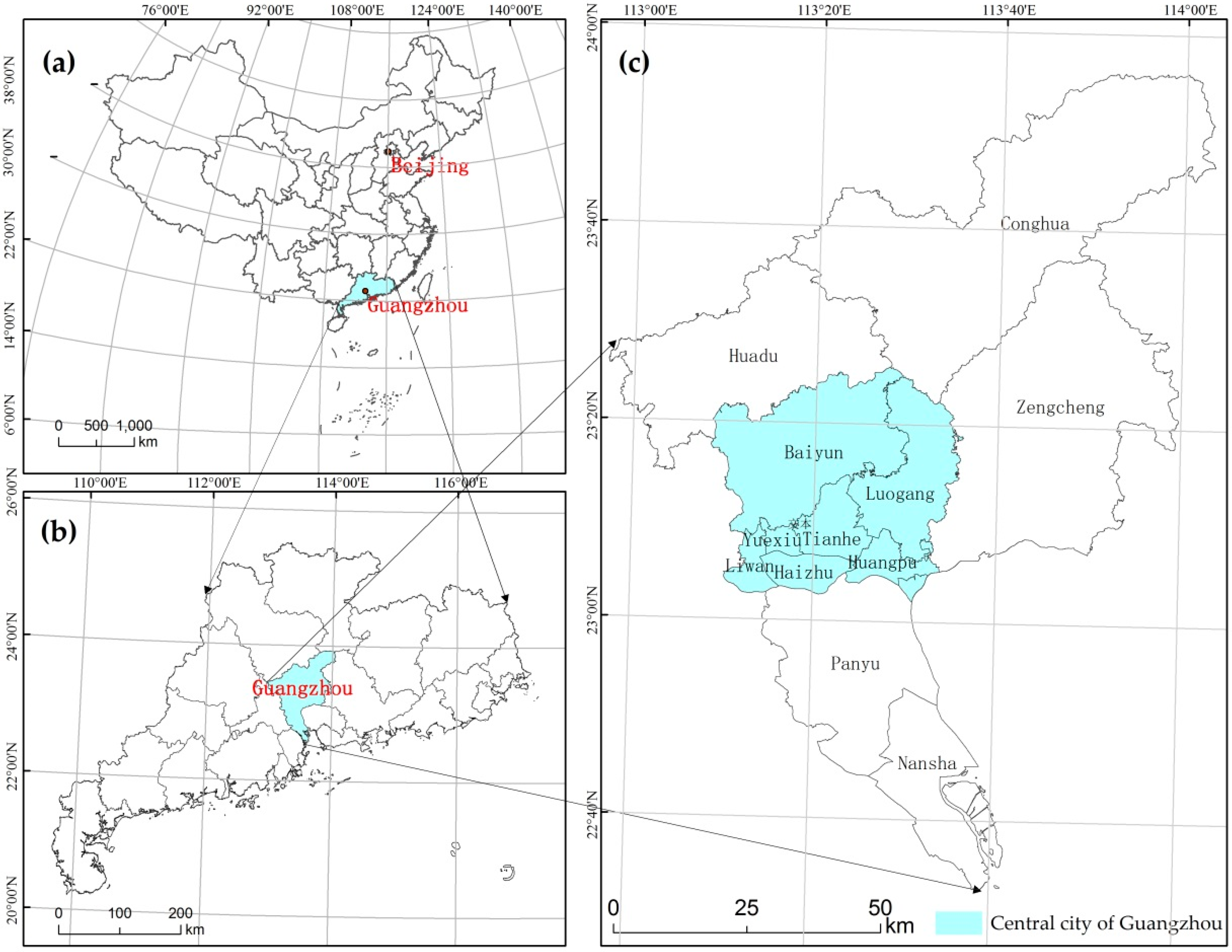
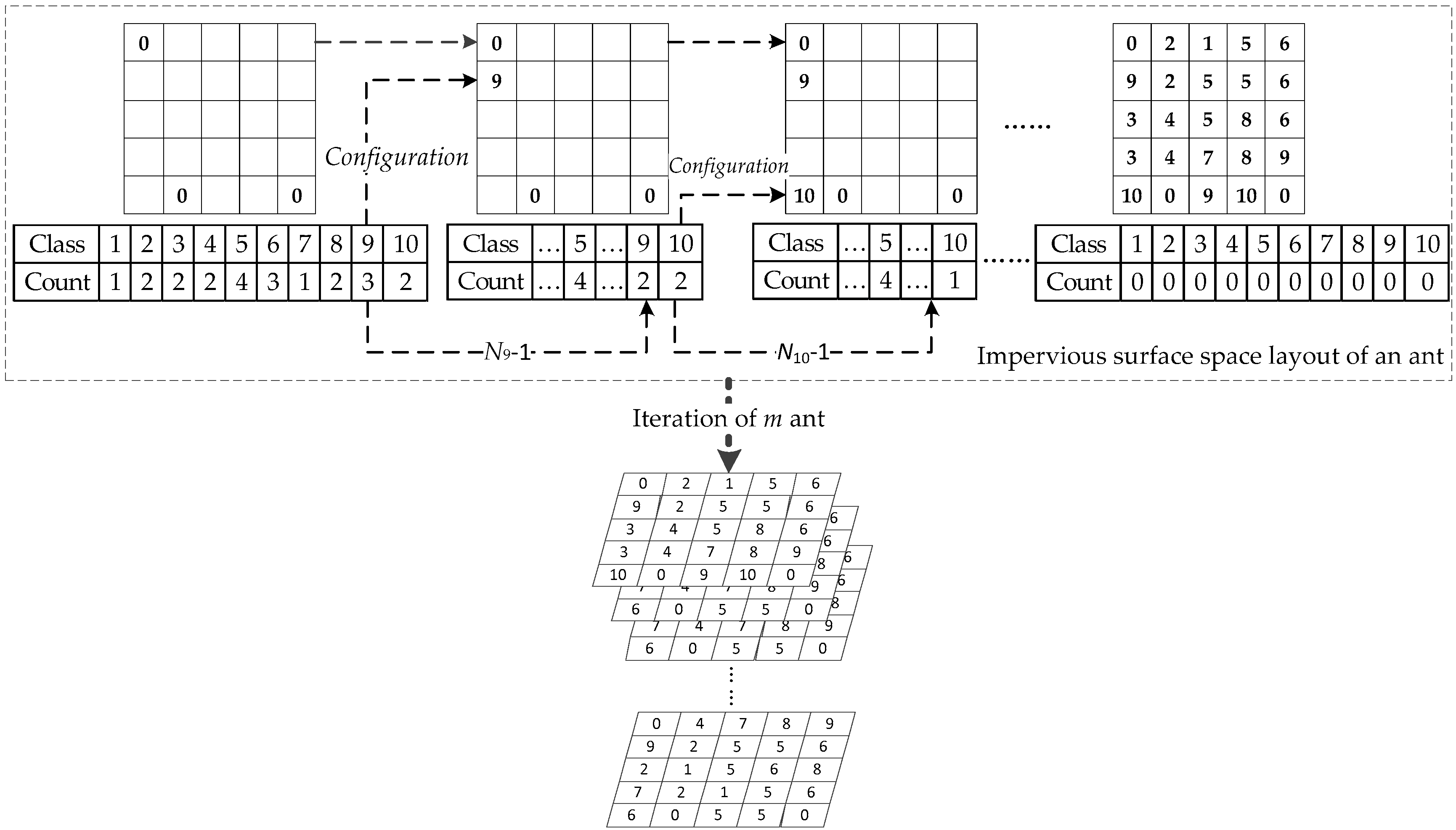
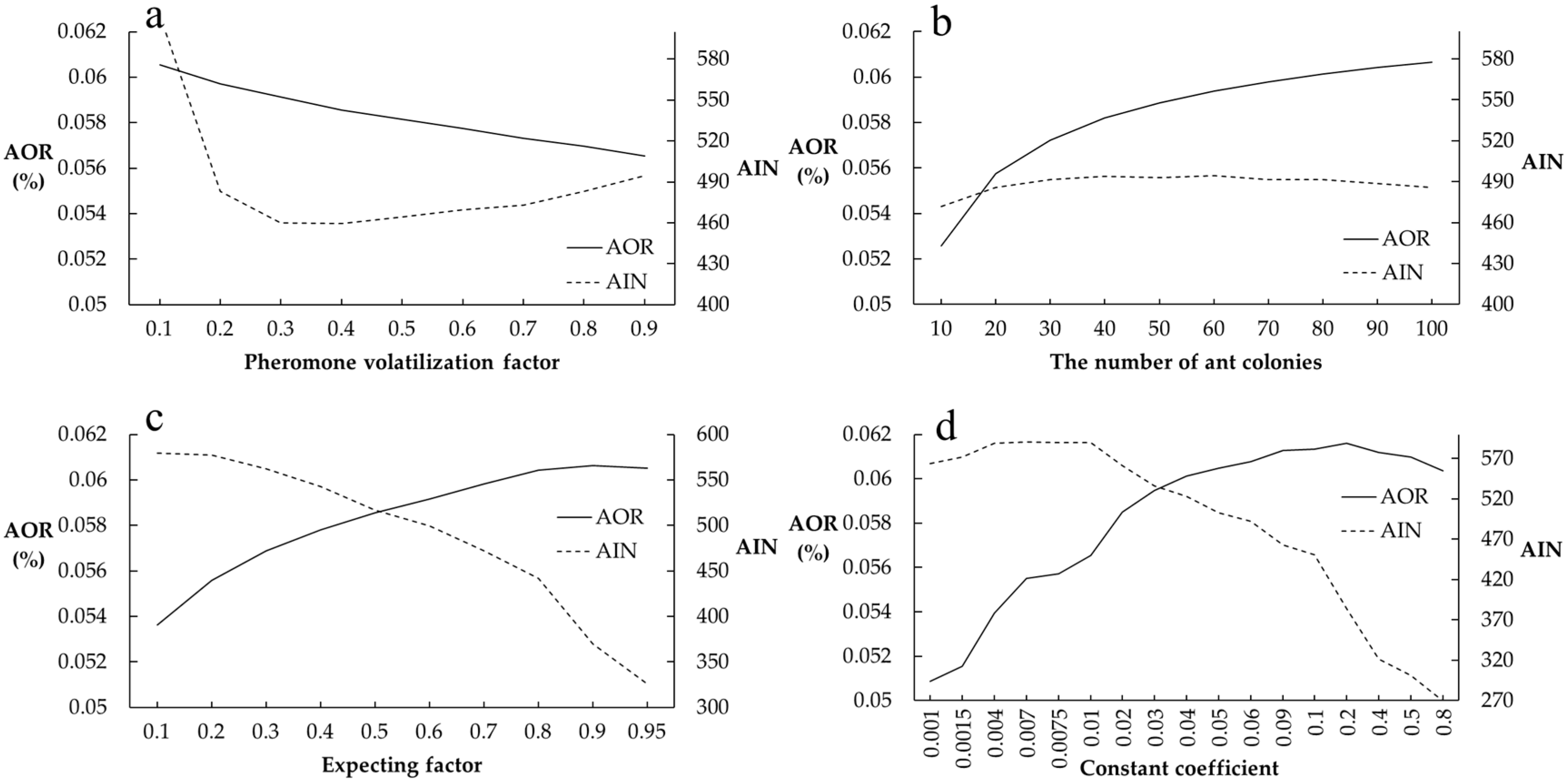
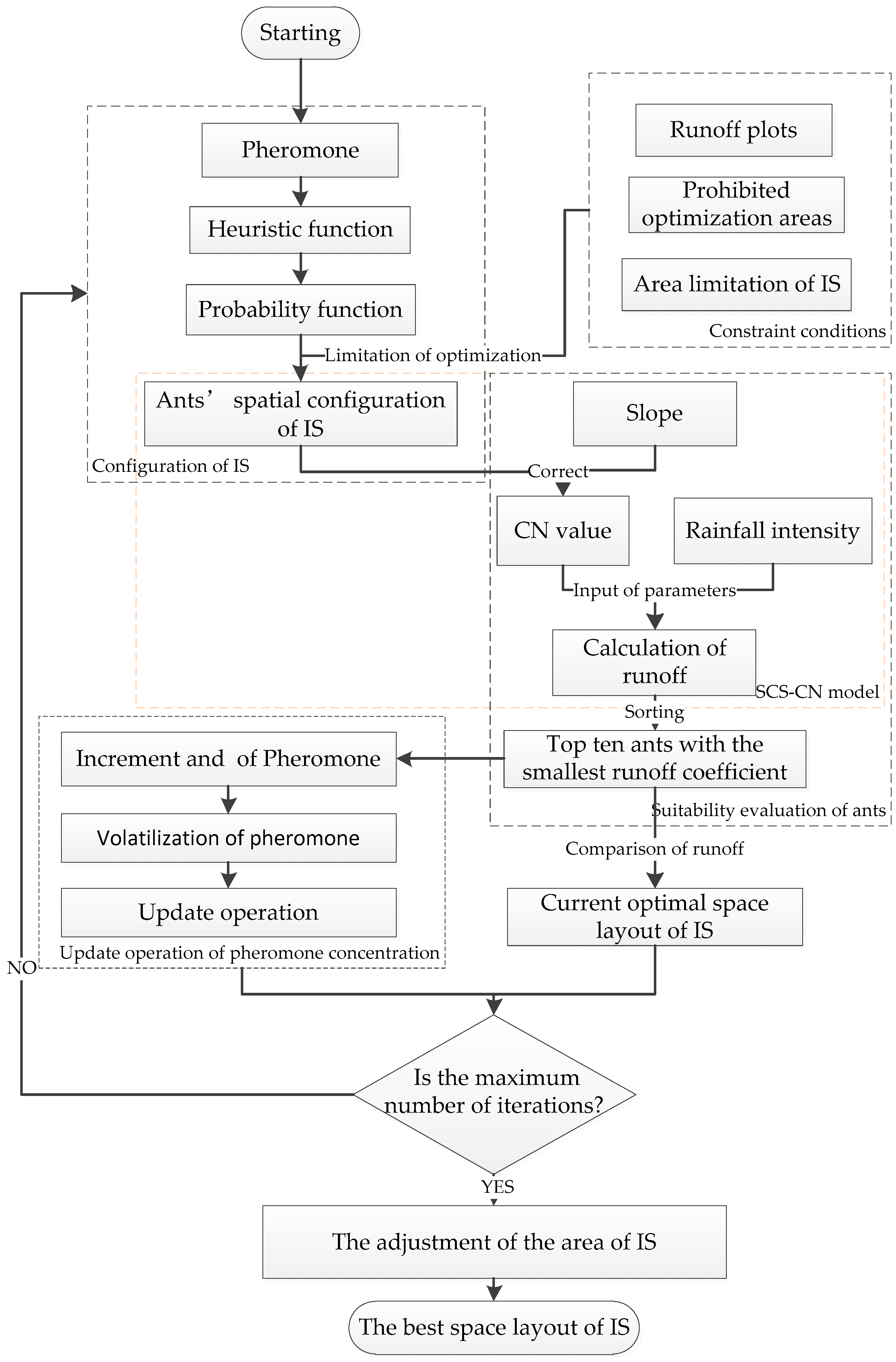


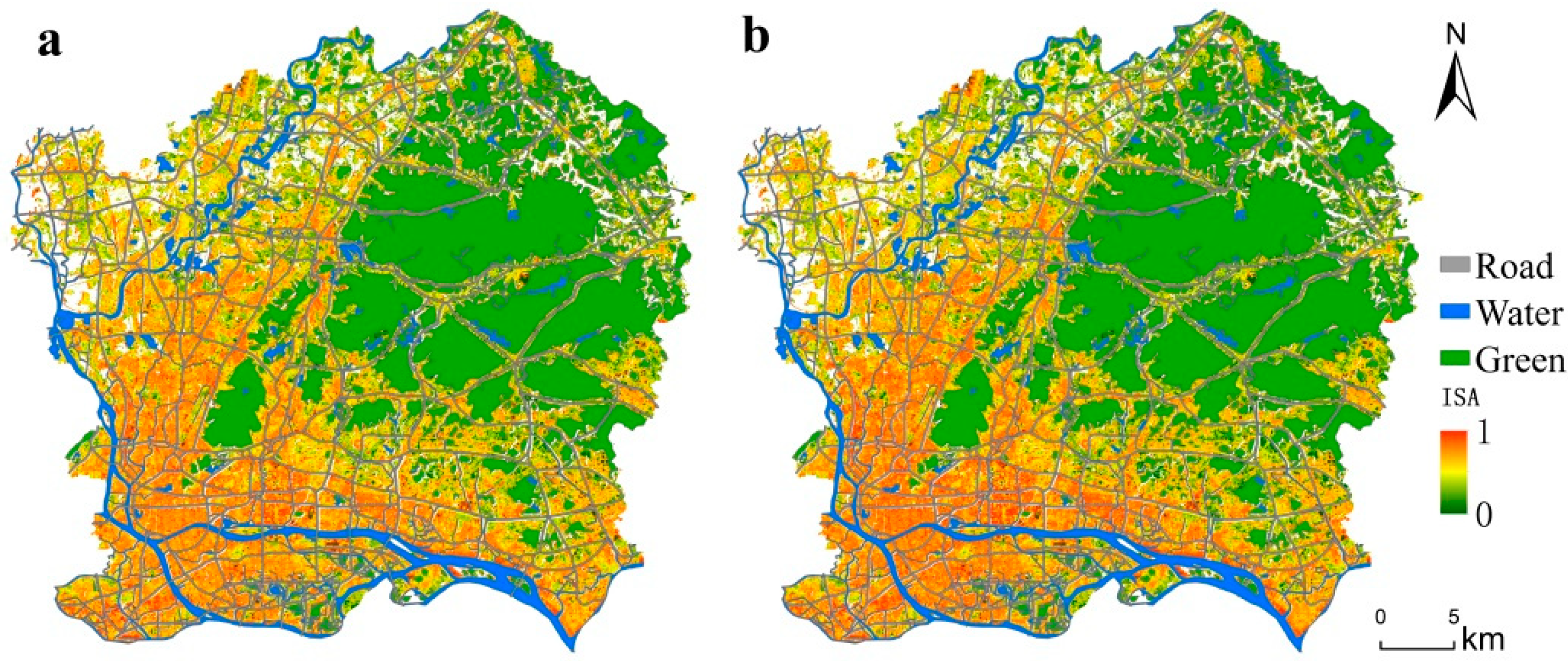
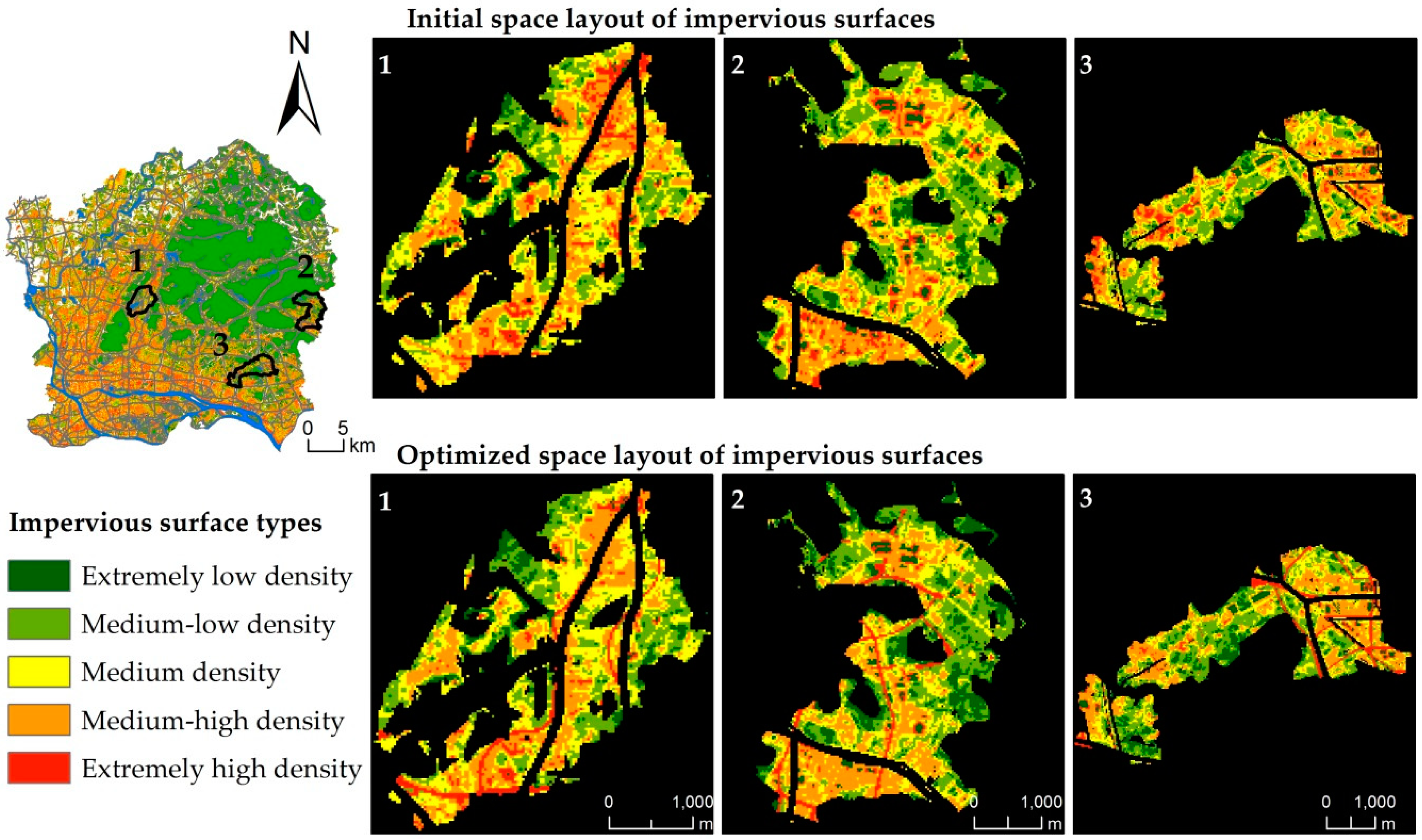

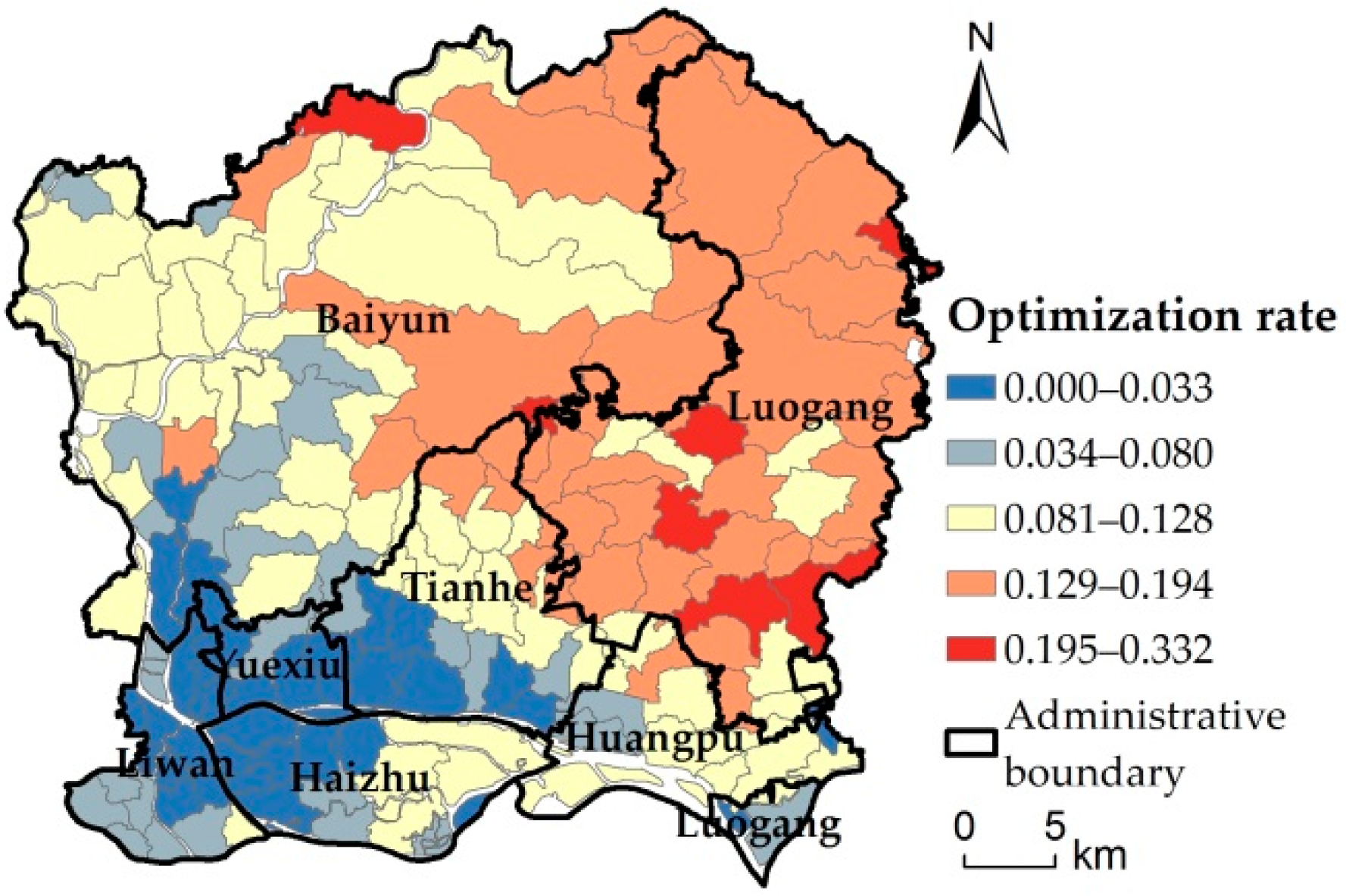
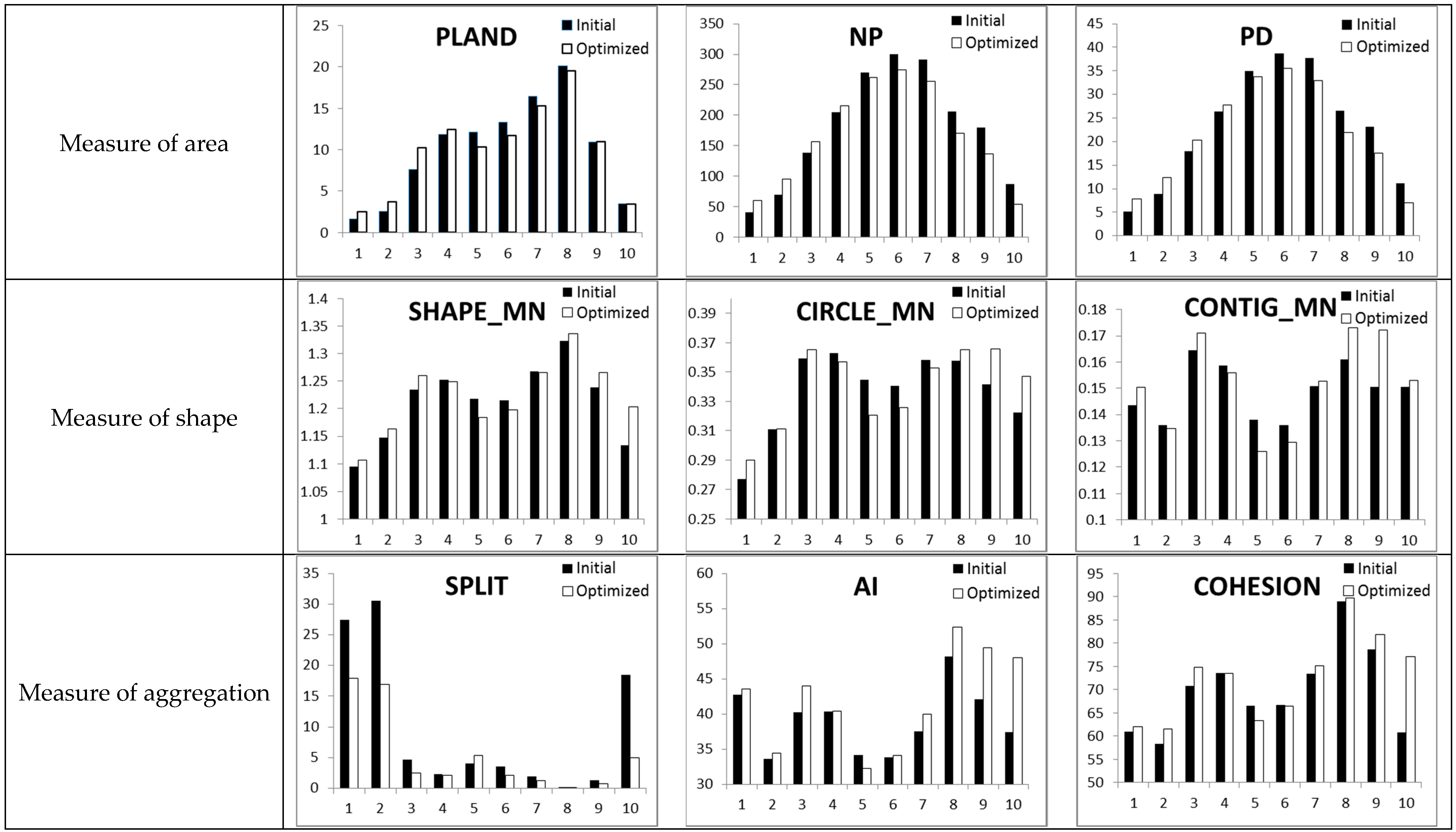

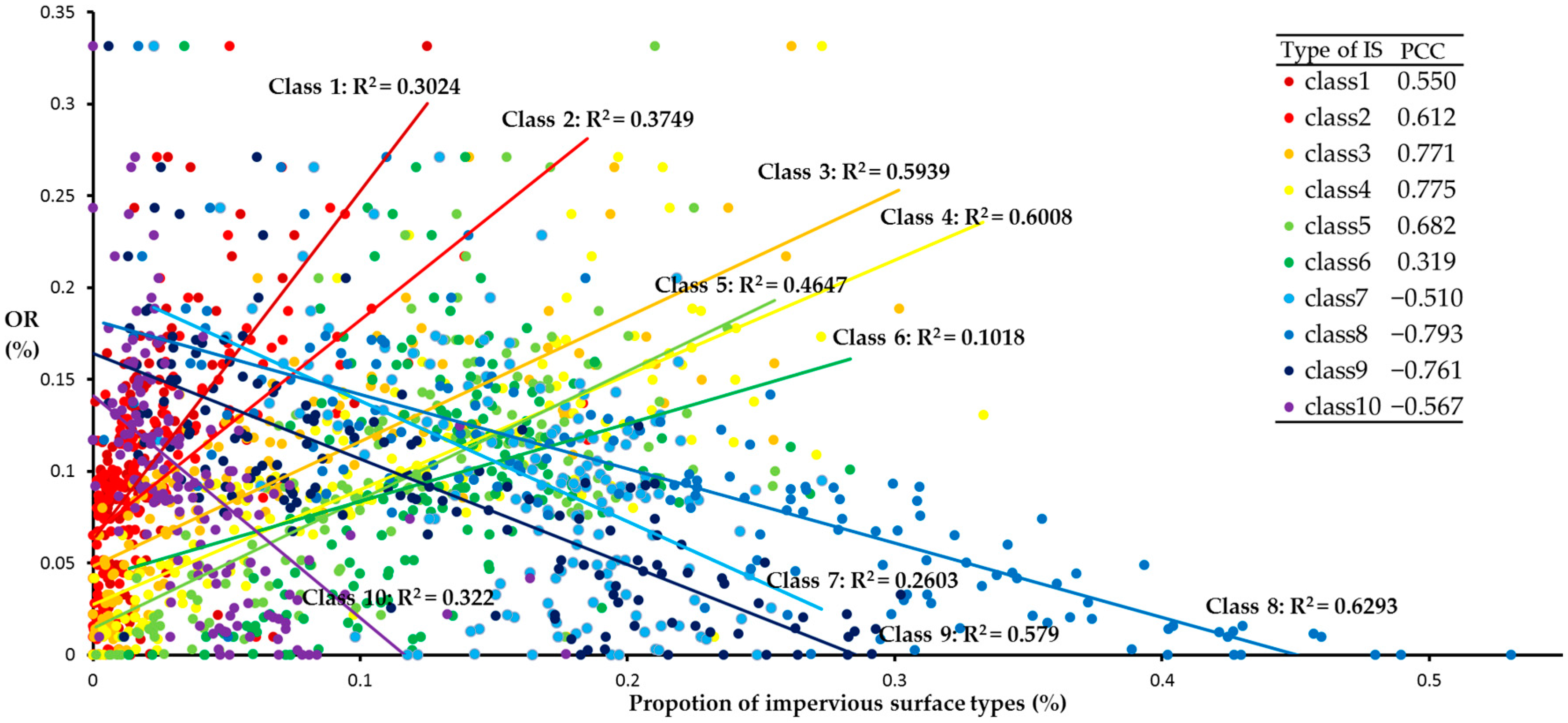
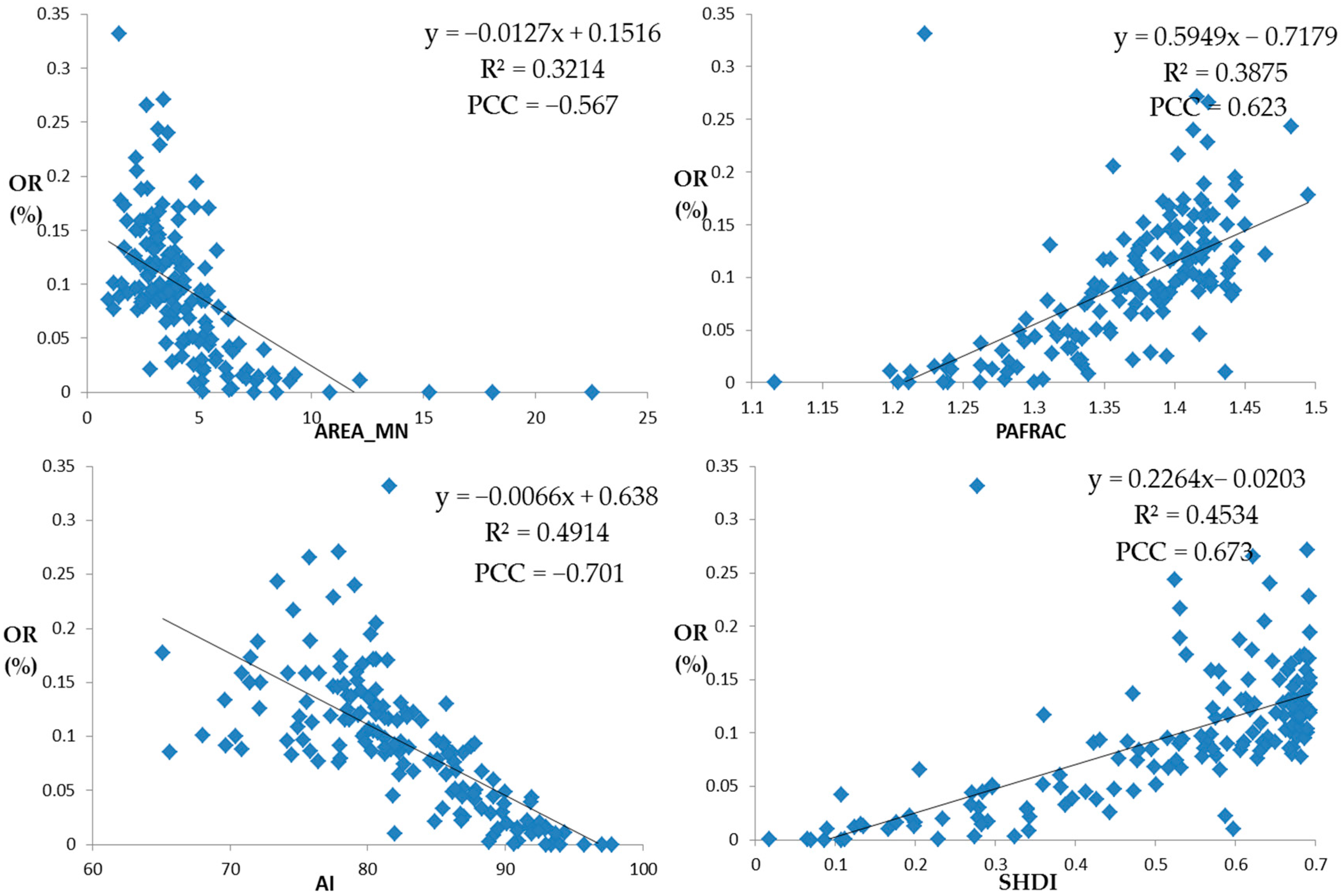

| Data | Format | Time | Source |
|---|---|---|---|
| 1:4 Million administrative divisions | Esri shapefile | 2005 | National Geomatics Center of China |
| Landsat remote-sensing image | Img | 28-10-2010 | United States Geological Survey |
| High-resolution remote sensing image | Jpeg | 2010 | Google Earth satellite imagery |
| ASTER GDEM | Img | 2009 | Land Processes Distributed Active Archive Center |
| Global soil classification standard data | Grid | 2009 | WestDC China |
| Land use data | Esri shapefile | 2010 | The second national land survey in Guangzhou |
| Urban runoff plots | Esri shapefile | 2009 | Study results of Li et al. [74] |
| Impervious Surface Density | 0–0.1 | 0.1–0.2 | 0.2–0.3 | 0.3–0.4 | 0.4–0.5 | 0.5–0.6 | 0.6–0.7 | 0.7–0.8 | 0.8–0.9 | 0.9–1 |
| Type Encoding | 1 | 2 | 3 | 4 | 5 | 6 | 7 | 8 | 9 | 10 |
| The Type of Impervious Surfaces | extremely low density | medium-low density | medium density | medium-high density | extremely high density | |||||
| Landscape Pattern Index | Unit | Value Range | |
|---|---|---|---|
| Measure of area | Percent of landscape (PLAND) | % | 0–100 |
| Number of patches (NP) | pcs | >0 | |
| Patch density (PD) | pcs/100 hm2 | >0 | |
| Measure of shape | Mean shape index (SHAPE_MN) | no | ≥1 |
| Mean related circumscribing circle (CIRCLE_MN) | no | 0–1 | |
| Mean contiguity index (CONTIG_MN) | no | 0–1 | |
| Measure of aggregation | Aggregation index (AI) | % | 0–100 |
| Splitting index (SPLIT) | no | ≥1 | |
| Patch cohesion index (COHESION) | no | ≥0 | |
© 2019 by the authors. Licensee MDPI, Basel, Switzerland. This article is an open access article distributed under the terms and conditions of the Creative Commons Attribution (CC BY) license (http://creativecommons.org/licenses/by/4.0/).
Share and Cite
Yu, H.; Zhao, Y.; Fu, Y. Optimization of Impervious Surface Space Layout for Prevention of Urban Rainstorm Waterlogging: A Case Study of Guangzhou, China. Int. J. Environ. Res. Public Health 2019, 16, 3613. https://doi.org/10.3390/ijerph16193613
Yu H, Zhao Y, Fu Y. Optimization of Impervious Surface Space Layout for Prevention of Urban Rainstorm Waterlogging: A Case Study of Guangzhou, China. International Journal of Environmental Research and Public Health. 2019; 16(19):3613. https://doi.org/10.3390/ijerph16193613
Chicago/Turabian StyleYu, Huafei, Yaolong Zhao, and Yingchun Fu. 2019. "Optimization of Impervious Surface Space Layout for Prevention of Urban Rainstorm Waterlogging: A Case Study of Guangzhou, China" International Journal of Environmental Research and Public Health 16, no. 19: 3613. https://doi.org/10.3390/ijerph16193613
APA StyleYu, H., Zhao, Y., & Fu, Y. (2019). Optimization of Impervious Surface Space Layout for Prevention of Urban Rainstorm Waterlogging: A Case Study of Guangzhou, China. International Journal of Environmental Research and Public Health, 16(19), 3613. https://doi.org/10.3390/ijerph16193613





